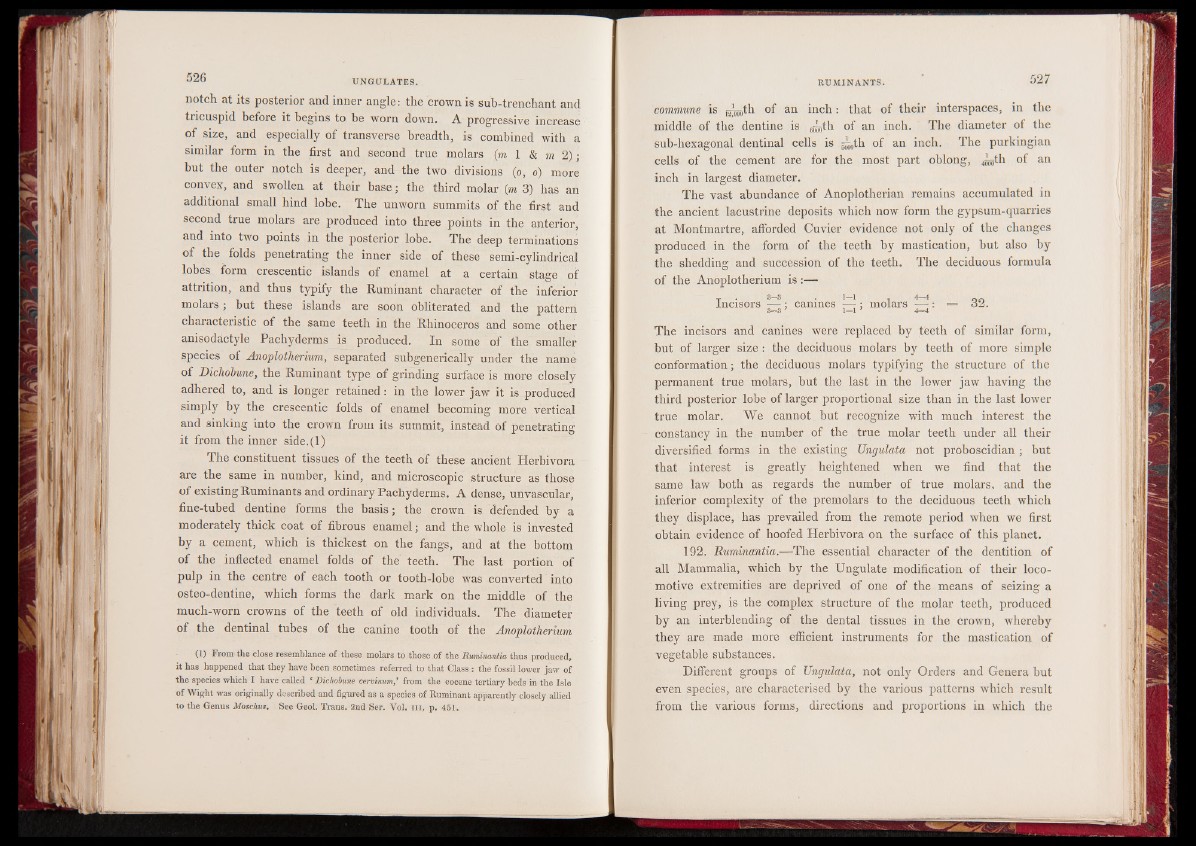
notch at its posterior and inner angle: the crown is sub-trenchant and
tricuspid before it begins to be worn down. A progressive increase
of size, and especially of transverse breadth, is combined with a
similar form in the first and second true molars (m l 8c m 2);
hut the outer notch is deeper, and the two divisions (o, o) more
convex, and swollen at their base; the third molar (m 3) has an
additional small hind lobe. The unworn summits of the first and
second true molars are produced into three points in the anterior,
and into two points in the posterior lobe. The deep terminations
of the folds penetrating the inner side of these semi-cylindrical
lobes form crescentic islands of enamel at a certain stage of
attrition, and thus typify the Ruminant character of the inferior
molars; but these islands are soon obliterated and the pattern
characteristic of the same teeth in the Rhinoceros and some other
anisodactyle Pachyderms is produced. In some of the smaller
species of Anoplotherium, separated subgenerically under the name
of Dichobune, the Ruminant type of grinding surface is more closely
adhered to, and is longer retained: in the lower jaw it is produced
simply by the crescentic folds of enamel becoming more vertical
and sinking into the crown from its summit, instead of penetrating
it from the inner side.(l)
The constituent tissues of the teeth of these ancient Herbivora
are the same in number, kind, and microscopic structure as those
of existing Ruminants and ordinary Pachyderms. A dense, unvascular,
fine-tubed dentine forms the basis; the crown is defended by a
moderately thick coat of fibrous enamel; and the whole is invested
by a cement, which is thickest on the fangs, and at the bottom
of the inflected enamel folds of the' teeth. The last portion of
pulp in the centre of each tooth or tooth-lobe was converted into
osteo-dentine, which forms the dark mark on the middle of the
much-worn crowns of the teeth of old individuals. The diameter
of the dentinal tubes of the canine tooth of the Anoplotherium
(1) From the close resemblance of these molars to those .of the Rwminantia thus produced,
it has happened that they have been sometimes referred to that Class : the fossil lower jaw of
the species which I have called ‘ Dichobune cervinumfrom the eocene tertiary beds in the Isle
of Wight was originally described and figured as a species of Ruminant apparently closely allied
to the Genus Moschus• ■ See Geol. Trans. 2nd Ser. Vol. n i, p. 451.
commune is jp^th of an inch: that of their interspaces, in the
middle of the dentine is 6«th of an inch. The diameter of the
sub-hexagonal dentinal cells is g^0th of an inch. The purkingian
cells of the cement are for the most part oblong, ^ th of an
inch in largest diameter.
The vast abundance of Anoplotherian remains accumulated in
the ancient lacustrine deposits which now form the gypsum-quarries
at Montmartre, afforded Cuvier evidence not only of the changes
produced in the form of the teeth by mastication, but also by
the shedding and succession of the teeth. The deciduous formula
of the Anoplotherium is :—
Incisors — ; canines 3H molars — : = 32.
The incisors and canines were replaced by teeth of similar form,
but of larger size : the deciduous molars by teeth of more simple
conformation; the deciduous molars typifying the structure of the
permanent true molars, but the last in the lower jaw having the
third posterior lobe of larger proportional size than in the last lower
true molar. We cannot but recognize with much interest the
constancy in the number of the true molar teeth under all their
diversified forms in the existing Ungulata not proboscidian; but
that interest is greatly heightened when we find that the
same law both as regards the number of true molars, and the
inferior complexity of the premolars to the deciduous teeth which
they displace, has prevailed from the remote period when we first
obtain evidence of hoofed Herbivora on the surface of this planet.
192. Ruminantia.—The essential character of the dentition of
all Mammalia, which by the Ungulate modification of their locomotive
extremities are deprived of one of the means of seizing a
living prey, is the complex structure of the molar teeth, produced
by an interblending of the dental tissues in the crown, whereby
they are made more efficient instruments for the mastication of
vegetable substances.
Different groups of Ungulata, not only Orders and Genera but
even species, are characterised by the various patterns which result
from the various forms, directions and proportions in which the